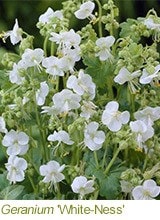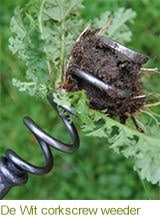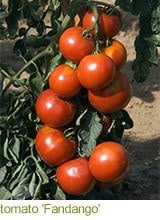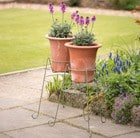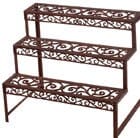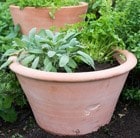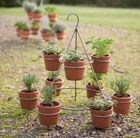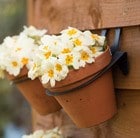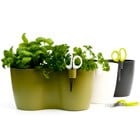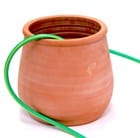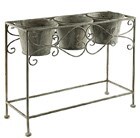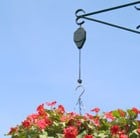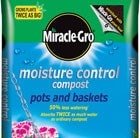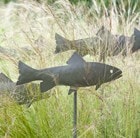|
Basic Container Sense
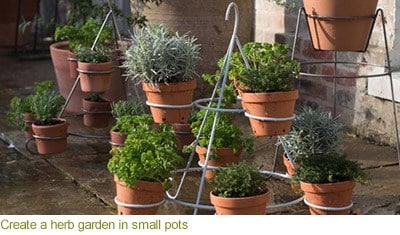
There are some basic rules to follow when choosing the right pot for your garden. The first is that it always looks much better if you go for the larger ones rather than lots of smaller ones. Also, if it’s a pot filled with summer colour that’s going to stand in the garden from May to October, you can be adventurous and choose less-rugged materials such as wicker, wood, or galvanized metal and wire baskets - materials that will survive a summer or two, but not really hard weather.
Permanent and Rugged
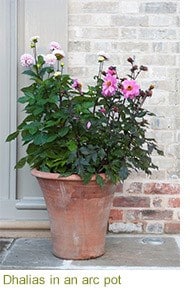 If you’re going for a more permanent display, which is going to stand there month after month you need to opt for rugged frost-proof pots such as terracotta or stone. These may be expensive, but they offer plants warmth and protection - and they will last for decades. Lightweight alternatives include fibreglass, like the Fern pot (which looks like terracotta). These would be rugged enough for year-long use and are great for roof terraces and balconies. Drainage holes should be kept open, so no crocks in the bottom of these permanently planted pots, and your pots should be elevated, by pot feet or another device such as wooden blocks, to allow water to freely drain away in wet winters. Otherwise it may freeze to hard surfaces and kill your plants. Given these considerations, a permanently planted pot is a delight, and it can offer a home for a wide range of plants that will cover all the seasons. If you’re going for a more permanent display, which is going to stand there month after month you need to opt for rugged frost-proof pots such as terracotta or stone. These may be expensive, but they offer plants warmth and protection - and they will last for decades. Lightweight alternatives include fibreglass, like the Fern pot (which looks like terracotta). These would be rugged enough for year-long use and are great for roof terraces and balconies. Drainage holes should be kept open, so no crocks in the bottom of these permanently planted pots, and your pots should be elevated, by pot feet or another device such as wooden blocks, to allow water to freely drain away in wet winters. Otherwise it may freeze to hard surfaces and kill your plants. Given these considerations, a permanently planted pot is a delight, and it can offer a home for a wide range of plants that will cover all the seasons.
Compost and Proportions
Whichever type of pot you choose, opt for a loam-based compost that is high in nutrients (such as John Innes 3) and fill to within 5cm of the top. This holds nutrients and moisture better than a light peaty compost, which is very unforgiving once it has dried out.
Shape Matters
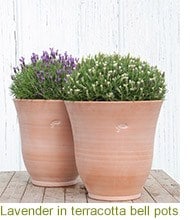 Tall pots that are narrow at the base and wider at the top (such as the Empoli lily pot) will blow over far more easily than an almost cylindrical pot with a wide base and equally wide top. This will be a consideration in windy gardens. If you want to grow moisture-loving plants, then choose a pot (like the Tulip pot) that has a narrow neck and bulbous sides. These fill with water far more easily and stay damp better than the others. The down side is that they are virtually impossible to empty and replant after the plants roots have filled the pot, so if you don't want this hassle, drop in a black plastic pot that’s just slightly smaller than the circumference of the pot’s top - so that you can lift it in and out. Tall Ali Baba pots are often not planted up, although they can be laid on their sides with two sprawling clematis (such as ‘Frances Rivis’ with C. macropetala ‘Lagoon‘ or the softer blue ‘Wesselton’) as Vita Sackville West did at Sissinghurst. A pot laid horizontally keeps drier, making it possible to grow this type of clematis. It’s also a good way to overwinter pots of agapanthus or lilies too, as these resent too much winter wet. Tall pots that are narrow at the base and wider at the top (such as the Empoli lily pot) will blow over far more easily than an almost cylindrical pot with a wide base and equally wide top. This will be a consideration in windy gardens. If you want to grow moisture-loving plants, then choose a pot (like the Tulip pot) that has a narrow neck and bulbous sides. These fill with water far more easily and stay damp better than the others. The down side is that they are virtually impossible to empty and replant after the plants roots have filled the pot, so if you don't want this hassle, drop in a black plastic pot that’s just slightly smaller than the circumference of the pot’s top - so that you can lift it in and out. Tall Ali Baba pots are often not planted up, although they can be laid on their sides with two sprawling clematis (such as ‘Frances Rivis’ with C. macropetala ‘Lagoon‘ or the softer blue ‘Wesselton’) as Vita Sackville West did at Sissinghurst. A pot laid horizontally keeps drier, making it possible to grow this type of clematis. It’s also a good way to overwinter pots of agapanthus or lilies too, as these resent too much winter wet.
Style also Matters
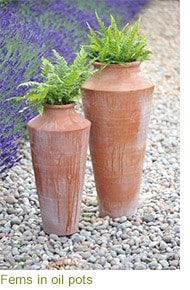
Elegant town houses need simple pots and the pot should be twice as deep as your planting if you’re aiming for slender elegance as these proportions work well visually. Country houses suit fussier pots, or ones with country motifs such as swags, or lattice, or flowers. Townhouses need simplicity - whether it’s rusted metal, or resin, or terracotta.
When it Comes to Planting
Single specimens work very well in pots, particularly in formal settings, and agapanthus, box cones, box spirals or swirling grasses (such as Carex testacea) stand well on their own. If however you want to create a mixed arrangement using several plants you must pack the plants in - far more than in the border, so that there are no large gaps.
Containers Need Food
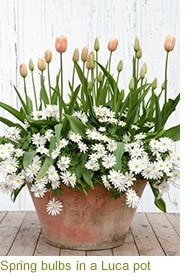 Whatever you’re growing feed it well. Aim for a slow release fertiliser for foliage, such as pelleted Vitax Q4 which can be added to the surface of the compost. Box (Buxus sempervirens) is a voracious feeder and if you starve it, it will take on a yellow metallic tinge that looks awful. Seaweed feed will restore green lustre and also toughen the foliage against box blight, a problem exacerbated by leaving tiny box snippets either in the box bush or underneath. Remove any clippings assiduously. Cones and spirals are more immune because water runs off them better than it does with balls. If you’re troubled by this problem variegated box, Buxus sempervirens ‘Elegantissima’, seems immune. Whatever you’re growing feed it well. Aim for a slow release fertiliser for foliage, such as pelleted Vitax Q4 which can be added to the surface of the compost. Box (Buxus sempervirens) is a voracious feeder and if you starve it, it will take on a yellow metallic tinge that looks awful. Seaweed feed will restore green lustre and also toughen the foliage against box blight, a problem exacerbated by leaving tiny box snippets either in the box bush or underneath. Remove any clippings assiduously. Cones and spirals are more immune because water runs off them better than it does with balls. If you’re troubled by this problem variegated box, Buxus sempervirens ‘Elegantissima’, seems immune.
If the plants are flowery opt for tomato feed and water it on every two weeks between late-April and late-August.
A well-fed permanently planted container can last up to three years. In most cases, at the end of those three years, your plants can either be potted up, or added to the garden.
A Herb Pot
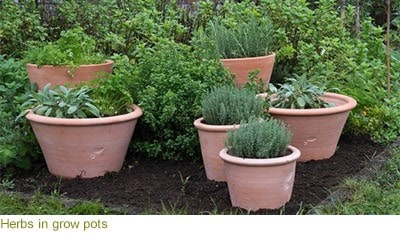
Herbs go very well in pots placed in a sunny position near the kitchen door. Opt for the herb collection, containing a mixture that usually includes mint, chives, sage, parsley and rosemary, if you’re planting up a medium-sized container. If you’re pots are larger, add tarragon, oregano and more chives and pop in the odd nasturtium seed - because their flowers are edible.
A Waterwise Pot
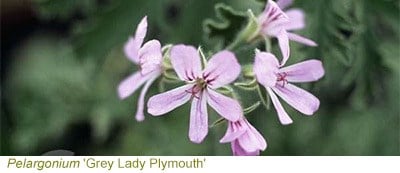
Scented-leaved pelargoniums are less fussy about being watered and can usually manage with a twice a week regime. Their foliage is aromatic, so doesn’t scorch, and it’s the foliage that creates the spectacle because the flowers tend to be small and insignificant. Pelargonium ‘Grey Lady Plymouth’ has variegated divided foliage. Add the peppermint-scented P. tomentosum, the softest and most-tactile scented leaved pelargonium of all, but be aware that this is a large, lax plant so position it at the back. ‘Orsett’ has showier mid-pink flowers blotched in maroon and ‘Lemon Fancy’ has bright-green divided foliage that exudes citrus.
 Add a lemon verbena, for soothing lemon scent that clings to the hand every time it’s touched, and a splash of purple heliotrope to add depth. This needs to be at the front so that it can curtsey, but keep an eye out for slugs. They will seek it out as effectively as any Dalek and exterminate overnight! Add a lemon verbena, for soothing lemon scent that clings to the hand every time it’s touched, and a splash of purple heliotrope to add depth. This needs to be at the front so that it can curtsey, but keep an eye out for slugs. They will seek it out as effectively as any Dalek and exterminate overnight!
If you want one superstar for a sunny position make it Pelargonium ‘Ardens’ an airy vision of tiny flowers the colour of molten lava. This will keep from year to year in a frost-free spot.
Agapanthus - Lilies of the Nile
 If there’s one plant that’s made for a round pot it’s the agapanthus. Many will grow in the ground, but in a pot they’re raised up to greater levels and they make much more impact on the eye. Good forms include ‘Brilliant Blue’, a newly-bred compact agapanthus that reaches only 60cm, but is packed with lots of blue flowers. Give this a shorter pot. The taller mid-blue ‘Taw Valley’ 80cm, has roundels of flower, with each individual petals lined in navy-blue. If there’s one plant that’s made for a round pot it’s the agapanthus. Many will grow in the ground, but in a pot they’re raised up to greater levels and they make much more impact on the eye. Good forms include ‘Brilliant Blue’, a newly-bred compact agapanthus that reaches only 60cm, but is packed with lots of blue flowers. Give this a shorter pot. The taller mid-blue ‘Taw Valley’ 80cm, has roundels of flower, with each individual petals lined in navy-blue.
‘Black Magic’, is a dark purple agapanthus, one of the blackest on offer, or if you want to go for pastel go for ‘Megan’s Mauve’ or the steely, almost metallic ‘Windsor Grey’. Don’t starve them as some people suggest, but feed them at regular intervals with tomato food between April and August - and do deadhead them after flowering. Be prepared to divide and repot them every three to four years, ideally as they begin to grow in spring. For some you will need a saw to separate them.
Shade Lovers
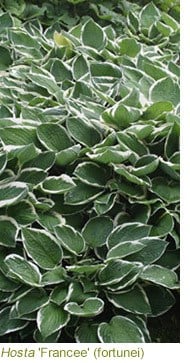 Pots in shade tend to be filled with leafy plants. They can either light up a dark corner, with their variegated or golden foliage, or provide a rich all-green tapestry of texture. If you’re going variegated use hostas on their own. They come in many hues, but the blue-leaved ones, which tend to prefer brighter light anyway, can look dull in shade. Instead opt for a dazzler such as the white and green ‘Patriot’ or the the luminous lime-green ‘June’, which is a muted combination of jade, lime and sage. Choose a pot without a snail and slug-hiding rim and check under the foliage at the first sign of attack. Pots in shade tend to be filled with leafy plants. They can either light up a dark corner, with their variegated or golden foliage, or provide a rich all-green tapestry of texture. If you’re going variegated use hostas on their own. They come in many hues, but the blue-leaved ones, which tend to prefer brighter light anyway, can look dull in shade. Instead opt for a dazzler such as the white and green ‘Patriot’ or the the luminous lime-green ‘June’, which is a muted combination of jade, lime and sage. Choose a pot without a snail and slug-hiding rim and check under the foliage at the first sign of attack.
Another option would be to make up a mixed collection that will cast some light. The hardy maidenhair fern with tiny lime-green leaves, Adiantum × mairisii, with the toning leafy Tiarella 'Iron Butterfly' (PBR) will put on a great show.
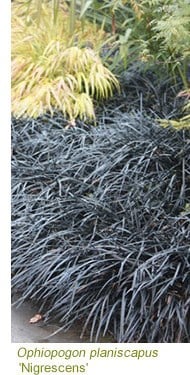 These share similar colours and a rounded leaf (though of different sizes) so separate them with a contrasting spiky plant like the dusky black Ophiopogon planiscapus ‘Nigrescens’, or the These share similar colours and a rounded leaf (though of different sizes) so separate them with a contrasting spiky plant like the dusky black Ophiopogon planiscapus ‘Nigrescens’, or the
deciduous golden grass Hakonechloa macra 'Aureola' planted at the edge. This light and shade combination can be completed with the lime-green heads of Hydrangea paniculata ‘Little Lime’ ('Jane') (PBR). Ferns are always good in pots in shade, because their emerging fronds are plant studies -changing day by day.
Fuchsias also do well in shade and you can opt for full-skirted rich-reds and purples, or elegant chandeliers in pearly colours. ‘Mrs Popple’ is a heritage hardy with red and purple single flowers. ‘Hawkshead’ is pale and interesting and both will survive outside although they must never be cut down until the shoots reappear in spring.
And Finally for Winter
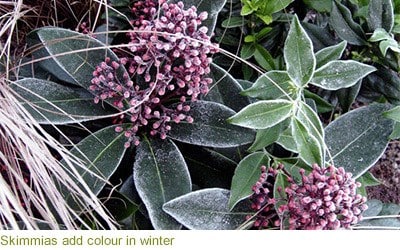
Lots of evergreens grow well in pots, but look for ones that have that little something extra to give during the darker months. Sarcococcas for example are sure winners, as their flowers will fill the air with with their sweet perfume throughout winter, while winter flowering heathers will add a blaze of colour. Skimmia japonica ‘Rubella’ is another all-time favourite. Its a male skimmia, so doesn’t produce the glossy red berries of the females, but instead you get conical clusters of red flower buds that appear in autumn and persist all the way through to mid-spring, when they finally burst open. For added height, top a large pot with an obelisk and let Clematis cirrhosa var. balearica scramble all over it. The lightly freckled flowers look pretty against the fresh green foliage, and will also keep bees and other pollinating insects coming back for a nectar fix in winter. |
Five things to do
|
















